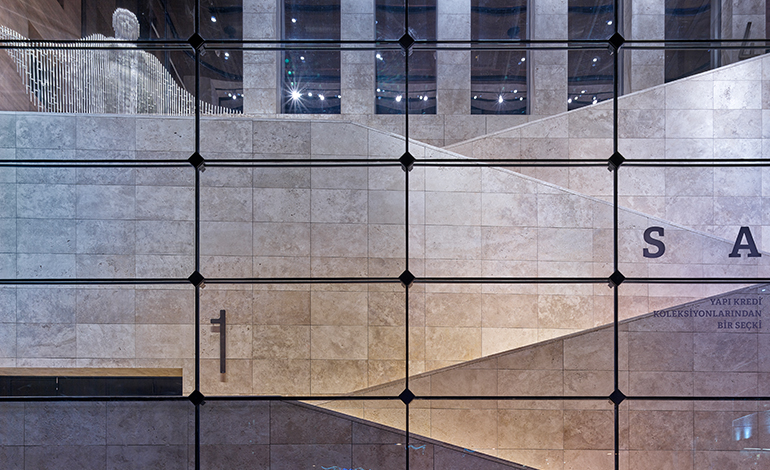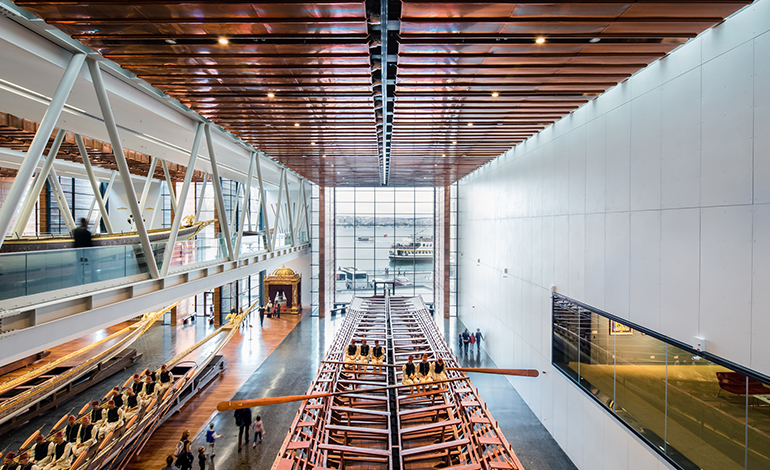İşbank Painting Sculpture Museum
2023
İş Bankası Resim Heykel Müzesi, iki pasaj bir çıkmaz arasında, kentin en önemli yaya arterlerinden biri olan İstiklal Caddesi üzerinde konumlanıyor. Geçmiş hayatlarındaki (Bodvi Apartmanı & 4. Sigorta Han) farklı yüzlerine (mağaza & banka) rağmen her dönemde şehirle zemin kotunda güçlü bir ilişki kuran bina, bugün Türkiye İş Bankası Resim Heykel Koleksiyonu’na ev sahipliği yapan bir müze olarak kapılarını açıyor.
İşbank Painting Sculpture Museum is located on Istiklal Street, one of the most important pedestrian arteries of the city, between two passages and a cul-de-sac. Despite its different faces (store & bank) in its past lives (Baudouy Apartment & 4th Sigorta Han), it establishes a strong relationship with the city at ground level in every period. Today, it opens its doors as a museum hosting the İşbank Painting Sculpture Collection.
Location
Beyoğlu, İstanbulConstruction Area
5.000 m²Client
Türkiye İş Bankası

Bugün İstiklal Caddesi üzerinde, Odakule Pasajı’nın hemen yanında konumlanan müze binasının hayatı 1907 yılında Bodvi Apartmanı olarak başlamış. Fransız tüccar Joseph Baudouy tarafından inşa ettirilen binanın zemin ve birinci katları, o zamanki komşusu olan Karlman Bonmarşesi’ne benzer şekilde mağaza olarak kullanılırken; üst katlar 19. yüzyıl Beyoğlu apartmanlarının tipik özelliklerini taşıyan daireler olarak tasarlanmış. Binanın ikinci hayatı ise 1950’lerde Türkiye İş Bankası tarafından satın alınmasıyla başlamış. Bu tarihten itibaren 4. Sigorta Han ismini alan binanın önceleri mağaza olan zemin ve birinci katları, 2010’lu yıllara kadar banka şubesi olarak işlev görmek üzere yapısal bir müdahaleyle dönüştürülmüş. Cepheye yapışık bir dizi odadan oluşan ve konut olan üst katlar ise özgün halinde bırakılarak ofis olarak kullanılmış.
The life of the museum building, which is located today on Istiklal Street, right next to the Odakule Passage, began in 1907 as the Baudouy Apartment. While the ground and first floors of the building, built by French merchant Joseph Baudouy, were used as stores, similar to its neighbor at the time, Karlman Bon Marche; the upper floors were designed as apartments with typical features of 19th century Beyoğlu buildings. The second life of the building began in the 1950s when it was purchased by İşbank and named 4th Sigorta Han from this date on. The ground and first floors of the building, previously stores, were transformed with a structural intervention to function as a bank branch until the 2010s. The upper floors, which were residences and consisted of a series of rooms attached to the façade, were left in their original state and used as offices.



Teğet’in dahil olacağı sürecin temelleri, yaklaşık 60 yılın ardından 2008 yılında İş Bankası Yönetim Kurulu’nun şubeyi “İş Bankası Sanat Eserleri Koleksiyonu”nun sergilenecegi bir müzeye dönüştürme kararına dayanıyor. Meşakkatli bürokratik bir sürecin ardından, 2015 yılında başlayan projelendirme ve inşa süreçleri 2023 yılında tamamlanıyor ve bina üçüncü hayatına İş Bankası Resim Heykel Müzesi olarak başlıyor.
The foundations of the process in which Teğet will be involved lie in the decision of the İşbank Board of Directors in 2008, after nearly 60 years, to transform the branch into a museum where the “İşbank Artworks Collection” will be exhibited. After a tedious bureaucratic process, the project planning and construction processes, started in 2015, are completed in 2023 and the building begins its third life as İşbank Painting Sculpture Museum.



Projenin ana yaklaşımı binanın yüz yılı aşkın zamana sığdırdığı üç ömrün sorumluluğunu üstlenmek ve bu katmanlı potansiyeli kullanmak üzerinden tariflenebilir. Tarihi bir binayı mekân kurgusunu, atmosferi, malzemeleri ve patinasıyla korumaya çalışırken bir yandan onu günümüz çağdaş müzesinin teknik ihtiyaçlarıyla donatmak ilk ve ana hedef. Binanın cephesine dizili birbirine eklemlenen oda silsilesine dokunmadan; bu etli kabuğun yapısını statik, mekanik ve elektrik yüklerle bozmadan, orijinal planda irili ufaklı servislerin bulunduğu iç kısıma çok işlevli ve teknolojik yeni bir çekirdek yapı önermek. Korunan kısmı zemine sabitleyen ve tesisat hacimlerini içeren güçlü bir betonarme yapı, ana tasarım problemine cevap veriyor. Aynı zamanda yüksek ve geniş sergi galerileri ile müzeye farklı bir mekan tipi sağlıyor.
The main approach of the project can be described as taking responsibility for the three lifespans of the building over a hundred years and using this layered potential. The first and main goal is to preserve a historical building with its spatial setup, atmosphere, materials and patina, while equipping it with the technical needs of today’s contemporary museum. Without touching the series of interconnected rooms arranged on the façade of the building; to propose a new multifunctional and technological core structure for the interior, where a number of services were located in the original plan, without damaging the structure of this thick shell with static, mechanical and electrical loads. A strong reinforced concrete structure that anchors the protected part to the ground and contains the installation volumes answers the main design problem. At the same time, it provides a different type of space for the museum with its high and wide exhibition galleries.



Orijinal yapı, kabuk, gün ışığıyla yıkanıyor; açık renklerde boyalı kübik mekânlarla kuruluyor. Çekirdek, koyu renk duvarları ve tavanlarından suni ışıkla aydınlanıyor. Kabukta tavanlar yüksek ve ferah, katları ayıran döşemeyi aşağıdan görebiliyorsunuz. Çekirdekse, asma tavanın içine yüklenmiş binaya ait ağır tesisatla daha basık. Duvarları armatürler, anahtarlar, hissedicilerle dolu. Asma tavanın içinde ilerleyen hatlar orijinal binayı besliyor; ona ısı, hava, enerji sağlıyor. Kabuktaki odaların duvarlarına yağlıboya tablolar asılmış. Çekirdekteki yüksek ve geniş galerilerdeyse, üç boyutlu yerleştirmeler ve heykeller yükseliyor, duvarları büyük ebatlı eserler kaplıyor.
The original structure, the shell, is bathed in sunlight; it is set up with cubic spaces painted in light colours. The core is illuminated with artificial light from its dark walls and ceilings. In the shell, the ceilings are high and spacious, and you can see the floor separating the floors from below. The core is flatter, with the building’s heavy plumbing installed inside the suspended ceiling. Its walls are full of fixtures, switches, sensors. The lines running through the suspended ceiling feed the original building; it provides heat, air and energy. Oil paintings are hung on the walls of the rooms in the shell. In the high and wide galleries in the core, three-dimensional installations and sculptures rise, and the walls are covered with large-scale works.




Projenin merkezinde, bu ikili mekan kurgusunun tam ortasında kalan tarihi merdiven ise restorasyon yaklaşımının bir parçası olarak korunuyor. Eş zamanlı ilerleyen yıkma-koruma-yapma faaliyetlerinin arasında zorlu operasyonlarla ayakta tutulan merdiven kovasının duvarlarında 7 kat boyanın altında bulunan kalem işleri tarihi ve yeni yapı arasındaki kati zıtlığı kırarak, tarihsel katmanları ortaya çıkarıyor. 1950’lerde bozulan cephe kurgusu özgün haline göre yeniden inşa edilirken, geri kalanın malzemeleri, süslemeleri ve patinası olduğu gibi korunuyor.
The historical staircase, which is at the center of the project, right in the middle of this dual space setup, is preserved as a part of the restoration approach. The hand-carved works under 7 layers of paint on the walls of the staircase, which is kept up through difficult operations amid simultaneous demolition-preservation-construction activities, reveal the historical layers, breaking the stark contrast between the historical and the new structure. While the façade structure, which was damaged in the 1950s, is rebuilt according to its original state, the materials, decorations and patina of the rest are preserved as they are.






Binanın zemin katı müze dükkan, kitabevi, kafe, çok amaçlı salon ve fuayesi; birinci katı yönetim ofisleri; ikinci, üçüncü, dördüncü ve beşinci katları sergi alanları; altıncı katı restoran olarak planlandı. Birbirinin neredeyse aynı olan sergi katları, yeni çekirdek yapı içindeki farklı galeri boşlukları ile birbirinden ayrılıyor. Katlar arasında bu galeriler üzerinden kesintisiz bir görsel deneyim kuruluyor.
The ground floor of the building contains a museum, shop, bookstore, cafe, multi-purpose hall and foyer; first floor management offices; the second, third, fourth and fifth floors are exhibition areas; the sixth floor was planned as a restaurant. The exhibition floors, which are almost identical to each other, are separated from each other by different gallery spaces within the new core building. An uninterrupted visual experience is established between the floors through these galleries.








İki pasaj, bir çıkmaz arasındaki müze binası kentin en önemli yaya arterlerinden biri olan İstiklal Caddesi üzerinde. Geçmiş hayatları (Bodvi Apartmanı & 4. Sigorta Han) ve farklı yüzlerine rağmen her dönemde şehirle zemin kotunda güçlü bir ilişki kurmuş. Kimi zaman bir mağaza, kimi zaman bir banka olarak. Bugün ise zemin katındaki farklı işlevlerle birlikte, İş Bankası Koleksiyonu’na ev sahipliği yapan bir müze olarak kapılarını açarken, şehirle olan bağını güçlendirerek sürdürüyor.
The museum building, between two passages and a cul-de-sac, is on Istiklal Street, one of the most important pedestrian arteries of the city. Despite its past lives (as Baudouy Apartment & 4th Sigorta Han) and different faces, it has established a strong relationship with the city at ground level in every period. Sometimes as a store, sometimes as a bank. Today, it continues to strengthen its connection with the city while opening its doors as a museum that hosts the İşbank Collection, with different functions on the ground floor.






